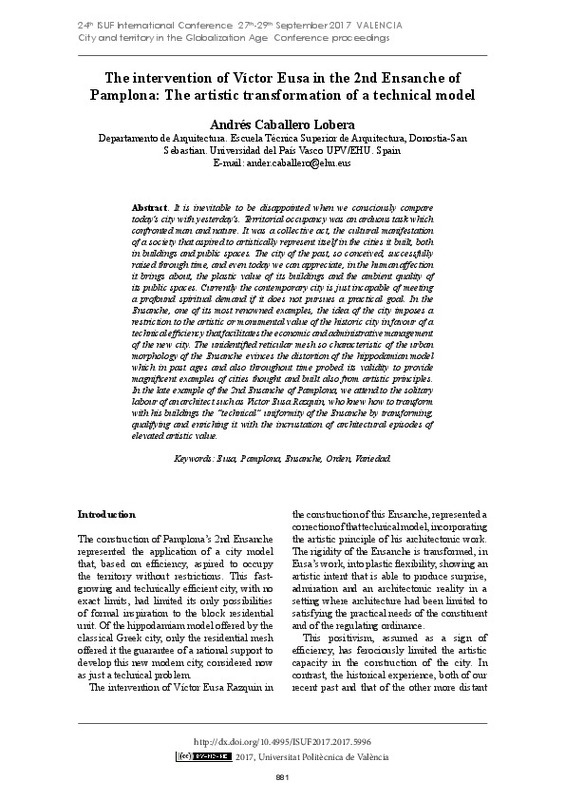JavaScript is disabled for your browser. Some features of this site may not work without it.
Buscar en RiuNet
Listar
Mi cuenta
Estadísticas
Ayuda RiuNet
Admin. UPV
V. Eusa’s Intervention in the 2nd Expansion of Pamplona: The artistic transformation of a technical model
Mostrar el registro sencillo del ítem
Ficheros en el ítem
| dc.contributor.author | Caballero, Andrés
|
es_ES |
| dc.coverage.spatial | east=-1.645774500000016; north=42.812526; name= Pamplona, Navarra, Espanya | es_ES |
| dc.date.accessioned | 2018-12-13T08:37:06Z | |
| dc.date.available | 2018-12-13T08:37:06Z | |
| dc.date.issued | 2018-04-20 | |
| dc.identifier.isbn | 9788490485743 | |
| dc.identifier.uri | http://hdl.handle.net/10251/113706 | |
| dc.description.abstract | [EN] It is inevitable to be disappointed when we consciously compare today’s city with yesterday’s. Territorial occupancy was an arduous task which confronted man and nature. It was a collective act, the cultural manifestation of a society that aspired to artistically represent itself in the cities it built, both in buildings and public spaces. The city of the past, so conceived, successfully raised through time, and even today we can appreciate, in the human affection it brings about, the plastic value of its buildings and the ambient quality of its public spaces. Currently the contemporary city is just incapable of meeting a profound spiritual demand if it does not pursues a practical goal. In the Ensanche, one of its most renowned examples, the idea of the city imposes a restriction to the artistic or monumental value of the historic city in favour of a technical efficiency that facilitates the economic and administrative management of the new city. The unidentified reticular mesh so characteristic of the urban morphology of the Ensanche evinces the distortion of the hippodamian model which in past ages and also throughout time probed its validity to provide magnificent examples of cities thought and built also from artistic principles. In the late example of the 2nd Ensanche of Pamplona, we attend to the solitary labour of an architect such as Victor Eusa Razquin, who knew how to transform with his buildings the “technical” uniformity of the Ensanche by transforming, qualifying and enriching it with the incrustation of architectural episodes of elevated artistic value. | es_ES |
| dc.format.extent | 9 | es_ES |
| dc.language | Inglés | es_ES |
| dc.publisher | Editorial Universitat Politècnica de València | es_ES |
| dc.relation.ispartof | 24th ISUF International Conference. Book of Papers | es_ES |
| dc.rights | Reconocimiento - No comercial - Sin obra derivada (by-nc-nd) | es_ES |
| dc.subject | Eusa | es_ES |
| dc.subject | Pamplona | es_ES |
| dc.subject | Ensanche | es_ES |
| dc.subject | Orden | es_ES |
| dc.subject | Variedad | es_ES |
| dc.title | V. Eusa’s Intervention in the 2nd Expansion of Pamplona: The artistic transformation of a technical model | es_ES |
| dc.type | Capítulo de libro | es_ES |
| dc.type | Comunicación en congreso | es_ES |
| dc.identifier.doi | 10.4995/ISUF2017.2017.5996 | |
| dc.rights.accessRights | Abierto | es_ES |
| dc.description.bibliographicCitation | Caballero, A. (2018). V. Eusa’s Intervention in the 2nd Expansion of Pamplona: The artistic transformation of a technical model. En 24th ISUF International Conference. Book of Papers. Editorial Universitat Politècnica de València. 881-889. https://doi.org/10.4995/ISUF2017.2017.5996 | es_ES |
| dc.description.accrualMethod | OCS | es_ES |
| dc.relation.conferencename | 24th ISUF 2017 - City and Territory in the Globalization Age | es_ES |
| dc.relation.conferencedate | Septiembre 27-29,2017 | es_ES |
| dc.relation.conferenceplace | Valencia, Spain | es_ES |
| dc.relation.publisherversion | http://ocs.editorial.upv.es/index.php/ISUF/ISUF2017/paper/view/5996 | es_ES |
| dc.description.upvformatpinicio | 881 | es_ES |
| dc.description.upvformatpfin | 889 | es_ES |
| dc.type.version | info:eu-repo/semantics/publishedVersion | es_ES |
| dc.relation.pasarela | OCS\5996 | es_ES |








